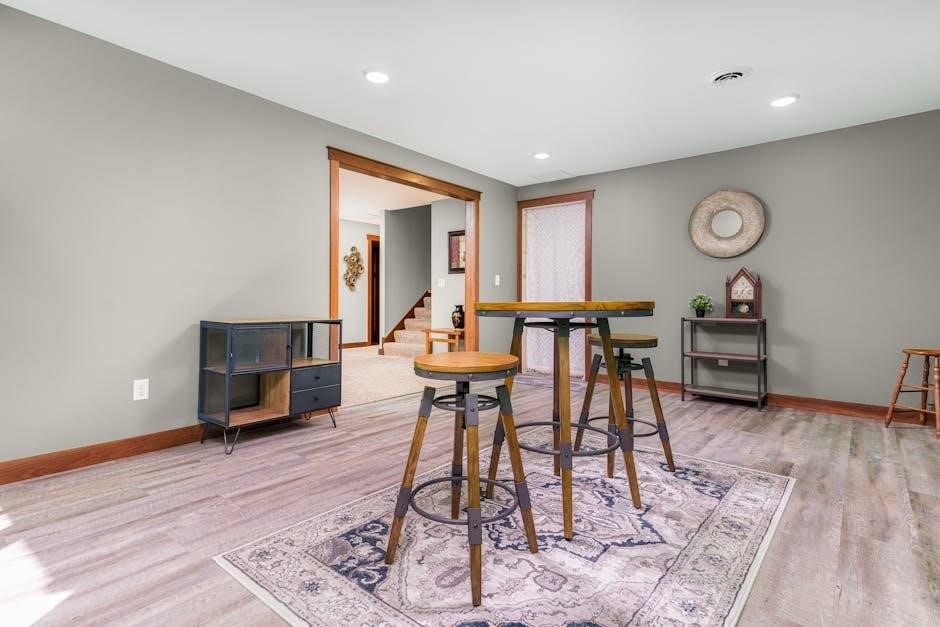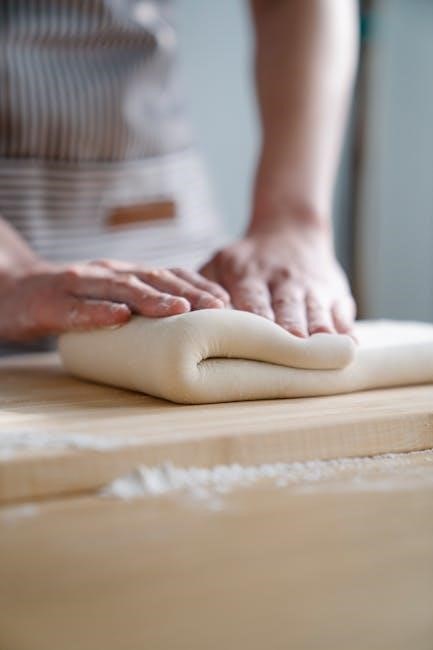Folding step stool plans PDF provide detailed instructions for creating foldable, portable step stools. These guide you through materials, tools, and step-by-step assembly, ensuring optimal functionality and customization for diverse projects.
1.1 What is a Folding Step Stool?
A folding step stool is a compact, portable tool designed for easier access to high places; Made from durable materials like wood, it features steps and a safety rail. The foldable design allows for easy storage and transport, making it ideal for both home and professional use. These stools are built with precision to ensure safety and stability, often featuring adjustable heights and secure locking mechanisms for added functionality.
1.2 Benefits of Using a Folding Step Stool
Folding step stools offer versatility, portability, and durability for various tasks. They provide easy access to high places, are lightweight for easy transport, and feature compact designs for space-saving. These stools are ideal for home use, workshops, or outdoor projects. They also come with adjustable heights, non-slip steps, and sturdy frames for safety. Folding step stools are cost-effective and customizable, catering to different needs and budgets.
Understanding Folding Step Stool Designs
Folding step stool designs vary in structure, materials, and functionality. They often include features like compact folding mechanisms, adjustable heights, and secure joints. These designs prioritize stability, portability, and customization to meet diverse user needs. Exploring different frameworks helps builders choose the best plan for their projects and preferences.
2.1 Types of Folding Step Stools
Folding step stools come in various designs, including compact, lightweight options for portability and heavy-duty models for industrial use. They may feature adjustable heights or multiple steps for versatility. Some are designed for home use, while others cater to commercial needs, ensuring functionality across different settings.
2.2 Key Features to Consider in a Folding Step Stool
- Portability: Look for designs that are lightweight and easy to fold. This ensures convenience for transporting and storing.
- Stability: Check for sturdy construction and anti-slip steps to ensure safety when in use.
- Material: Opt for durable wood types that are both strong and lightweight, such as plywood or MDF.
- Adjustability: Consider stools with height-adjustable features for versatility in different settings.
- Durability: Choose hardware and fasteners that are high quality to ensure long-lasting performance.
- Safety: Ensure the stool has a secure locking mechanism when folded or unfolded for added reliability.
Materials Needed for Building a Folding Step Stool
High-quality wood such as plywood or pine, bolts, nuts, handles, and hinges are essential; The plans PDF provides detailed specifications for selecting materials to ensure durability and functionality for different uses.
3.1 Recommended Wood Types for Folding Step Stools
Plywood and pine are popular choices for their durability and flexibility. Cedar and maple are also excellent options due to their natural resistance to moisture and pests. Choose wood types based on your project needs, ensuring it is strong enough for folding mechanisms while remaining lightweight. Always opt for sustainably sourced wood for eco-friendly construction.
3.2 Hardware and Fasteners for Assembly
Quality hardware, such as bolts, screws, and nuts, is essential for secure assembly. Use bolts with washers for stability and self-tapping screws for quick installation. Include hinges for the folding mechanism and durable fasteners for joints. Waterproof glue can reinforce connections. Opt for stainless steel hardware to resist rust and ensure longevity. Choose fasteners that balance durability and weight to maintain portability and strength.
Tools Required for Building a Folding Step Stool
Building a folding step stool requires essential tools like saw, drill, measuring tape, clamps, and sander. A mixing hand tools and power tools ensures precision and efficiency in cutting, drilling, and assembling the components outlined in the PDF plans.
4.1 Essential Hand Tools
Folding step stool construction requires a selection of versatile hand tools. These include a sturdy screwdriver for assembling hardware, a measuring tape for precise cuts, a adjustable wrench for securing bolts, clamps to hold pieces in place during assembly, a utility knife for cutting materials, and a chisel for creating joints or edges. These tools ensure accuracy and ease in following PDF plans.
4.2 Power Tools for Efficient Construction
Power tools areessential for efficient folding step stool construction. A cordless drill ensures quick screwing and drilling, while a circular saw makes precise cuts for custom fits. A sander helps achieve smooth surfaces, and a miter saw enables accurate angled cuts for joints. An impact driver speeds up the assembly process, while a jigsaw is handy for intricate designs. These tools enhance precision and save time when following PDF plans.

Finding the Best Folding Step Stool Plans PDF
High-quality folding step stool plans PDF are widely available online, offering detailed blueprints for various designs and skill levels. Ensure you select plans that include clear diagrams, materials lists, and step-by-step instructions for a seamless building experience.
5.1 Where to Download Folding Step Stool Plans
Folding step stool plans PDF can be downloaded from websites like Etsy, Big Cartel, or YouTube posts. Professional woodworking blogs and forums often offer free or premium plans. Checking online marketplaces for detailed, high-quality blueprints is also a great option for finding reliable resources.
5.2 Tips for Choosing High-Quality Plans
When selecting folding step stool plans PDF, prioritize clear diagrams and detailed instructions. Look for plans that include material lists, safety guidelines, and customizable options. High-quality PDFs often feature precise measurements and step-by-step guidance, ensuring your project is both functional and durable. Always preview or read reviews before purchasing or downloading to ensure the plans meet your needs.
Step-by-Step Guide to Building a Folding Step Stool
16.2 Choosing the Best Folding Step Stool Plan for You
When selecting a folding step stool plan PDF, consider your skill level, available tools, and intended use. Opt for detailed, clear instructions with diagrams. Ensure the plan aligns with your budget and desired materials for a successful, durable project tailored to your needs.
6.1 Preparing the Materials
Begin by selecting high-quality wood, such as oak or pine, and sand it for smooth surfaces. Measure and cut the wood according to the plan’s specifications. Gather necessary hardware, such as hinges and bolts, and ensure all tools are ready. Organize materials in a clean workspace to streamline the assembly process; Safety gear, like gloves and goggles, should also be prepared beforehand.
6.2 Assembling the Frame
Align the frame pieces according to the plan, using clamps to hold them in place. Drill pilot holes for screws to prevent splitting the wood;Attach hinges and bolts securely, ensuring the joints are tight and the frame is sturdy. Double-check measurements to guarantee proper alignment and functionality of the folding mechanism;
6.3 Adding the Steps and Safety Rail
Cut the steps to the required length, ensuring they align with the frame dimensions. Attach each step securely using screws or brackets, checking for even spacing and stability. Install the safety rail next, positioning it according to the plan and ensuring it’s sturdy for added support. Double-check all connections and tighten any loose parts for a safe and functional design.
6.4 Finishing Touches
Smooth all edges and corners to ensure safety. Apply a protective finish, such as stain or paint, to enhance durability and aesthetics. Attach hardware, like handles or grips, for added functionality. Conduct a final inspection to confirm all parts are secure and the stool folds properly. Test the stool for stability before full use.

Customizing Your Folding Step Stool
Customize your folding step stool by adding handles, a shelf, or other features. Paint or stain it to match your style. Modify the design for specific uses, such as outdoor or heavy-duty applications, to make it uniquely yours.
7.1 Adding Optional Features
Enhance your folding step stool by adding optional features like handles, wheels, or a built-in tool tray. Consider extendable legs for height adjustment or anti-slip pads for safety. Optional features can make your stool more versatile, practical, and tailored to your specific needs and preferences.
7.2 Painting and Staining Options
Painting and staining your folding step stool adds both style and protection. Choose from oil-based, acrylic, or water-based paints for vibrant finishes. Consider textured coatings for a non-slip surface. Staining preserves the wood’s natural beauty while enhancing durability. Follow the plans’ guidelines for optimal preparation and application techniques to ensure a long-lasting, professional finish.
Folding Step Stool Plans for Different Uses
Folding step stool plans cater to various needs, from home use in gardening or home improvement to commercial settings like workshops. Home plans prioritize convenience and safety, while commercial-grade designs focus on durability and weight capacity. Choose plans tailored to these specific applications for optimal performance and versatility.
8.1 Plans for Home Use
Folding step stool plans for home use focus on versatility and practicality. Designed for daily tasks such as changing light bulbs or reaching high shelves, these plans prioritize portability and ease of storage. Home-use plans often include features like durable wood, sturdy hinges, and lightweight construction. Additionally, customizable options allow you to add safety rails or non-slip steps for added convenience and safety in various indoor and outdoor settings.
8.2 Plans for Commercial Use
Folding step stool plans for commercial use emphasize functionality, durability, and heavy-duty construction. Designed to withstand frequent use and harsh environments, these plans prioritize materials like thick plywood or metal frames. Features such as reinforced hinges, non-slip steps, and high weight capacities ensure safety and longevity. Commercial plans often include options for branding, customization, and easy maintenance, making them ideal for businesses and industrial settings.

Folding Step Stool Plans for Advanced Woodworkers
Advanced folding step stool plans challenge skilled woodworkers with intricate designs, precision cuts, and complex joinery. These plans often feature custom dimensions, unique aesthetics, and enhanced durability, catering to the expertise of experienced craftsmen.
9.1 Advanced Design Modifications
Advanced design modifications for folding step stools include integrating safety features like reinforced joints, ergonomic handles, and multi-height adjustments. Custom details such as decorative panels or inset shelves can enhance functionality and aesthetics. Modifying materials and incorporating innovative mechanisms further pushed the boundaries of design flexibility.
9.2 Tips for Perfecting the Fold Mechanism
9.2 Tips for Perfecting the Fold Mechananism
Perfecting the fold mechanism involves meticulous attention to joint alignment and hinge placement. Ensure precise measurements for smooth folding action and secure locking. Reinforce pivot points and test the mechanism for durability. Fine-tune the fold angles for optimal ergonomics and usability. Use high-quality hardware to achieve seamless functionality and longevity in your design.

Expert Tips for Building a Folding Step Stool
Start with durable materials like hardwood and ensure precise cuts for stability. Double-check measurements and pre-drill holes to avoid splitting wood. Follow the plan’s instructions carefully and test the fold mechanism before final assembly
10.1 Common Mistakes to Avoid
To build a reliable folding step stool, avoid rushed measurements or improper cuts. Don’t overlook testing the fold mechanism for smooth operation. Ensure hinges or joints are secure to prevent wobbling. Avoid using inadequate materials that compromise durability and safety. Double-check blueprint instructions to prevent assembly errors.
10.2 Best Practices for Safety and Durability
Begin with selecting high-quality materials, such as treated wood or metal for longevity. Reinforce joints and use durable fasteners to ensure stability. Test the fold mechanism frequently during assembly. Apply protective finishes like paint or sealant to prevent wear. Label parts clearly for safe handling and assembly. Regular maintenance and inspections enhance longevity and safety.

Maintaining Your Folding Step Stool
Clean your folding step stool regularly with a soft cloth to remove dirt and moisture. Store it in a dry, cool place to prevent warping or rust. Inspect for wear and tighten loose parts to ensure longevity and safety; Proper care extends the stool’s durability and functionality over time.
11.1 Cleaning and Storage Tips
Regularly clean your folding step stool with mild soap and water to maintain its appearance and longevity. Wipe down all surfaces, focusing on hinges and crevices, then allow them to dry thoroughly. Store the stool in a dry, cool place when not in use to prevent warping or mold growth. Always fold the stool properly and store it upright to preserve its shape and functionality. Regular inspections ensure it remains safe and ready for use.
11.2 How to Repair Damage
Inspect your folding step stool for loose joints, cracks, or rust. Tighten or reinforce connections using wood glue and clamps for wooden parts or bolts for metal components. For minor surface damage, sand and refinish areas using matching stain or paint. Replace severely damaged parts, like steps or hinges, to ensure safety and structural integrity. Regular maintenance prevents further wear and prolongs the stool’s lifespan.

Folding Step Stool Plans for Different Budgets
Folding step stool plans PDF cater to varied budgets, offering affordable and durable options that ensure safety, functionality, and quality solutions without compromise.
12.1 Budget-Friendly Plans
Folding step stool plans PDF often include budget-friendly options, using affordable materials like salvaged wood or lightweight metals. These designs prioritize cost-effective construction while maintaining durability. Many plans emphasize simple assembly, making them ideal for DIY enthusiasts with limited resources._budget-friendly plans also feature minimal hardware, reducing costs without compromising safety.
12.2 High-Quality, Long-Lasting Plans
High-quality folding step stool plans PDF focus on durable materials like hardwoods and reinforced joints, ensuring longevity. These designs often include professional-grade fasteners and construction techniques for exceptional strength. Many plans feature optional enhancements, such as adjustable steps or storage compartments, to meet diverse needs. Proper care and maintenance tips are also provided to extend the stool’s lifespan and maintain its structural integrity.

Folding Step Stool Plans for Different Skill Levels
Folding step stool plans for different skill levels cater to both beginners and experienced woodworkers by offering basic to advanced designs. These PDFs include customization options, additional features, and adjustments tailored to skill sets, helping users build confidence and improve their craftsmanship.
13.1 Plans for Beginners
Folding step stool plans for beginners are designed to be simple and easy to follow, often with clear diagrams and concise instructions. These PDFs focus on basic techniques, essential tools, and fundamental joints
13.2 Plans for Intermediate Woodworkers
Folding step stool plans for intermediate woodworkers offer more advanced design features, such as customizable dimensions or improved fold mechanisms. These PDFs include guidance on selecting stronger materials, constructing durable joints, and ensuring efficient construction for lasting durability. Adjustments for stability and functionality are often detailed.

Folding Step Stool Plans for Different Heights
Folding step stool plans PDF offer options for various heights, from compact designs for low steps to taller units for extended reach. These versatile plans ensure customization to suit specific needs, balancing portability, functionality, and sturdiness for different applications.
14.1 Plans for Short Stools
Folding step stool plans PDF include compact, lightweight designs tailored for short-height applications. These plans focus on portability and adaptability, making them ideal for low-rise tasks. They ensure stability, ease of use, and efficient storage. Customizable features allow users to meet specific needs, offering versatile solutions in various settings.
14.2 Plans for Tall Stools
Folding step stool plans PDF include tall stool designs for reaching higher areas comfortably. These plans emphasize stability, durability, and ease of use, with adjustable heights and multiple steps for diverse tasks. Tailored for both home and professional environments, tall stools are lightweight yet sturdy, ensuring portability and adaptability to various projects and preferences.

Folding Step Stool Plans for Different Weight Capacities
PDF plans for folding step stools offer options tailored to weight needs, from lightweight designs for portability to heavy-duty builds for durability. These plans ensure safety and reliability across various usage scenarios, providing adaptable solutions for users of all types.
15.1 Plans for Lightweight Use
Folding step stool plans for lightweight use prioritize portability and ease of movement. These PDF designs often feature materials like lightweight plywood, aluminum brackets, or durable plastic. Their compact design and ergonomic construction ensure functionality without sacrificing stability. Perfect for homeowners or professionals, these plans emphasize durability and usability, making them ideal for frequent relocation or storage.
15.2 Plans for Heavy-Duty Use
Folding step stool plans for heavy-duty use focus on durability and strength, ideal for industrial or professional settings. These plans often utilize thick hardwoods, steel brackets, and reinforced joints to ensure stability under significant weight. Designed for longevity, they feature robust construction, heavy-duty hinges, and a sturdy frame, making them suitable for demanding tasks and frequent use.
Folding step stool plans PDF offer diverse options for various needs, ensuring safety, durability, and customization. These guides empower you to build functional, reliable step stools tailored to your requirements. With the right materials and tools, your project will meet both practicality and aesthetic expectations. Happy building!
16.1 Summary of Key Points
Folding step stool plans PDF offer detailed, customizable designs for building durable and versatile step stools. They include essential features, material recommendations, assembly instructions, and tips for optimal performance. These plans ensure safety, durability, and practicality tailored to different needs, making them a valuable resource for DIY projects.
When selecting folding step stool plans, consider functionality, budget, and skill level. Evaluate the plan’s design for portability, weight capacity, and ease of assembly; Assess the materials required and ensure they align with your preferences. Always opt for reputable sources and consider reviews or tutorials if available. Choose a plan that matches your specific needs and ensures long-lasting performance for various uses.